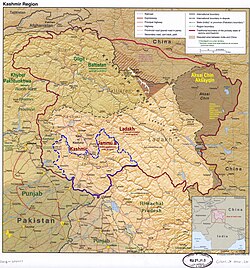Kathua | |
|---|---|
City | |
Clockwise from top left: View of canal near Kathua Waterfront, Industrial Estate, Jasrota Fort, Purthu artificial beach | |
 Interactive map of Kathua | |
 Kathua lies in the Jammu division (neon blue) of the Indian-administered Jammu and Kashmir (shaded in tan) in the disputed Kashmir region. [1] | |
| Coordinates: 32°23′06″N75°31′01″E / 32.385°N 75.517°E | |
| Administering country | India |
| Union territory | Jammu and Kashmir |
| District | Kathua |
| Settled | 1025 BC [2] |
| Named after | "KATHAI" [3] |
| Government | |
| • Type | Municipal Council |
| • Body | Kathua Municipal Council (21) Seats |
| • Chairman Municipal Council | Naresh Sharma (BJP) |
| Area | |
• Total | 28.32 km2 (10.93 sq mi) |
| Elevation | 393 m (1,289 ft) |
| Population (2011) | |
• Total | 59,866 |
| • Density | 3,765/km2 (9,750/sq mi) |
| Languages | |
| • Spoken | Dogri, Hindi and Urdu |
| Time zone | UTC+5:30 (IST) |
| PIN | 184101(HEAD OFFICE), 184104(Mini Secretariat) |
| Telephone code | 01922 |
| Literacy | 86.46% |
| Website | http://kathua.nic.in/ |
| [4] [5] [6] [7] | |
Kathua is a city and municipal council of the Jammu division of Indian-administered Jammu and Kashmir in the disputed Kashmir region. [1] The city is the headquarters of Kathua district and is divided into 27 wards which constitute the Kathua Municipal Council. It is situated along NH-44. The city has a bustling industrial area and an army cantonment adjoining it. Being a transit hub for industrial activity in the state, the city has a large industrial base with a textile park, biotechnology and pharma industrial and research park, cement industry, and many medium-scale MSMEs. [4] [5] [6] [7]








